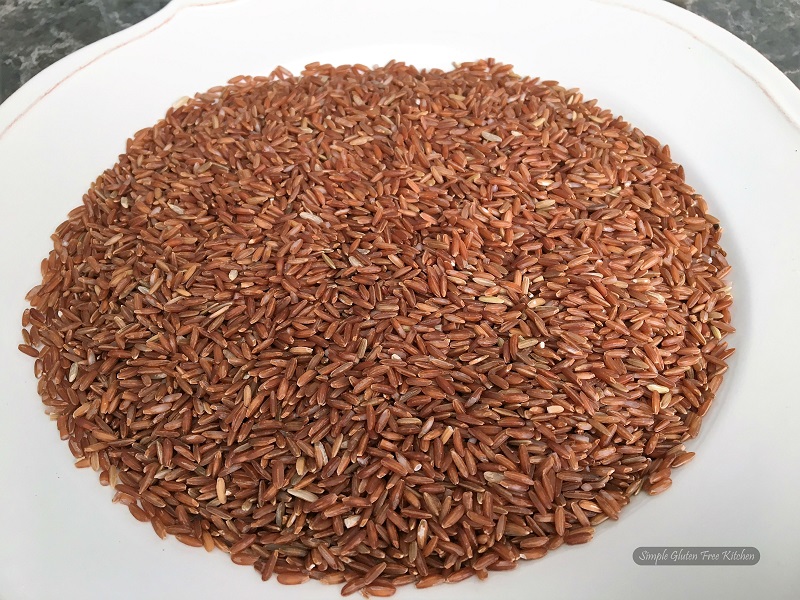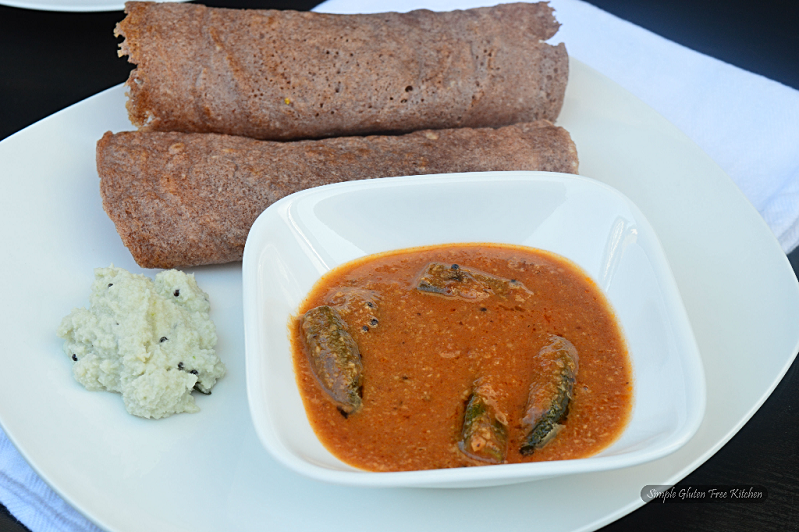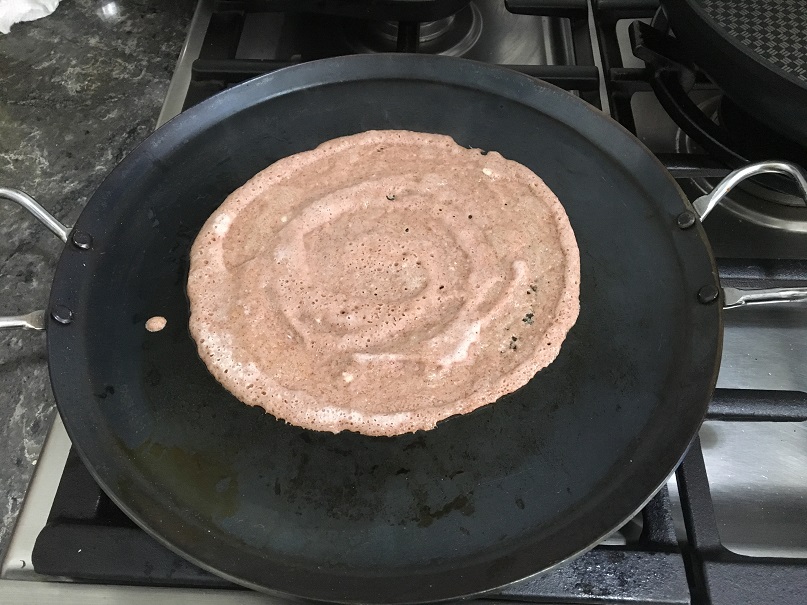Dosa is one of my favorite foods to make and eat. It is a south Indian fermented crepe, usually made gluten-free using a combination of white rice and lentils. Red rice dosa is a variation of the traditional white rice dosa. This is healthy and very tasty, slightly thicker than the standard white rice dosa.

Red Rice is a special variety of rice that is available both hulled and unhulled and derives its red/maroon color from anthocyanins. As an unhulled rice, red rice has a nutty flavor and high nutritional value from the germ. There are a few varieties of Red Rice available in the market, including Bhutanese Red Rice, Wehani Rice, Kerala Red Rice, Colusari Red Rice, Khao Deng Red Rice, Red Cargo Rice, etc. I purchased Bhutanese red rice for this recipe from a Canadian grocery store but it can also be purchased at Southeast Asian grocers and specialty food markets. If you don’t have access to any of these stores try finding red rice online or completely replace red rice for brown rice in the same proportion. Both have similar nutritional profiles. However, if you had to choose between the two choose red rice for dosa and brown rice for eating on a daily basis. Because red rice requires less soaking time as compared to brown rice and it has twice the amount of iron and 6 times the amount of zinc.

Dosa is very simple to prepare, but the batter does need to sit for a day for fermentation before it’s cooked. Fermenting rice and lentils make them high in live cultures of good bacteria. Plus, they also increase the absorption of vital minerals from the gastrointestinal tract, thus preventing mineral deficiencies.
If gluten is not the issue you can use red rice flour and urad flour for a short cut option that requires no soaking and grinding. These flours can be purchased from Indian stores carrying South Indian products. The other option is to grind your own flour in a high powered blender. After grinding you must sift the flour to get the superfine texture like you purchase it in the stores.
Dosa might be seen as a breakfast item but you can of course, serve this for lunch or dinner with any chutney, lentil soup or any vegetable or meat curry. Red rice dosa is pretty sturdy, and pliable by the way so you can easily make wrap out of it if you are not in a mood to have it with curry. We enjoyed ours with the conventional coconut chutney and okra curry.


Thick, chewy, delicious and loaded with live bacteria. A healthier alternative to a standard white rice dosa.
Ingredients
- 1 1/2 cup red rice
- 1/2 cup white split and skinned urad dal
- 1 tsp methi dana /fenugreek seeds
- 1 tsp salt
- 1 cup fresh grated or thawed frozen coconut
- 2 tbsp. fried split Bengal gram daal (or 1 tbsp roasted chickpea flour)
- Salt to taste
- 1 green chili
- 1/2" piece ginger
- 2 tsp oil
- few curry leaves
- 3/4 tsp rai (mustard seeds)
Instructions
- Soak the urad dal along with fenugreek seeds and red rice separately in water for a minimum of 6 hours. (urad dal tends to increase in volume so use the container which has twice the volume of daal).
- Meanwhile make coconut chutney, In a mixer/grinder, add grated coconut, fried split Bengal gram daal, green chili, ginger and salt. Pulse it a few times to form a coarse paste. Then adding small amounts of water pulse again to obtain a paste. Transfer this to a bowl.
- For tempering heat oil in a small pan. Once it is heated, reduce the heat. Add curry leaves and rai. Once mustard seeds start to splutter remove pan from heat and pour it over the chutney, mix.
- After 6 hours drain water from the daal and rice and reserve (it will be used while grinding).
- Take rice and grind with sufficient water until it is a smooth paste. You can use a blender and depending on the size of the jar, you can ground it in one or two batches. The amount of water used to grind is somewhat crucial, using too much will make the result too watery, while using too little will make it hard to grind and too thick. So use water as needed. Touch the paste between your fingers to feel the texture, which should be slightly coarse than white rice. Transfer the rice batter in a large bowl.
- Now grind the dal. It should be ground while slowly adding water from the top of the blender. When ground, the dal has the tendency to fluff up, this tendency must be encouraged by adding only a little water at a time while stirring and continuing to grind. The dal should double in quantity after grinding, while the quantity of rice remains unchanged.
- Now mix the ground daal with rice batter. Add salt, mix it again.
- Leave for about 8 hours or overnight in a dark warm place for fermentation. (During cold weather keep the batter inside the oven with oven light on).
- During fermentation the batter volume increase. Stir the batter with a spoon. If it looks thick, add few tablespoons of water and mix well until it has attained pouring consistency.
- Heat a heavy cast-iron griddle (a flat non-stick pan will do, but lacks the taste and texture that comes from the iron pan).
- Sprinkle few drops of water on the surface. If water drops sizzle and evaporate within few seconds, your griddle is hot enough to cook.
- Rub the surface of griddle with an oiled paper towel and reduce the heat. The tava should not be too hot when you spread the batter.
- Take a deep ladle full of batter and drop in the middle of the griddle, then with a deftness that comes with practice, quickly swirl the dough away from the middle until it is spread evenly in a circle around the pan. You must do this quickly because once the batter cooks, you cannot spread it and the result will be lumpy (Don't go back over the batter to fill in holes, they're a natural part of most dosas).
- Take a teaspoon full of oil and spread it around the edge of the dosa. Wait a minute or so, until you see the edges browning and insert a flat spatula that has sharp edges under and all around the dosa, until it is released completely.
- After releasing the dosa, flip it around on the other side and put another teaspoon of oil around the edges. Wait a minute or two until it is cooked and remove from the griddle. Before making the next one, wipe griddle with clean wet cloth (this is to prevent dosa from sticking to the surface of griddle).
- Repeat the process from 12-15 for remaining batter. This whole procedure sounds tedious, but it's not too hard after you've done it a few times.
- Serve hot dosas with coconut chutney, sambar or any vegetable or meat curry.
Notes
Skinned and Split White Lentils (Urad Dal) are the white seeds of the whole urad also called black lentils that have had their hulls removed, then split in half.
Sharing this recipe with Recipeoftheweek.

Angie@Angie's Recipes
They look fantastic! What is urad dal? Yellow split peas?
Balvinder
Thank You, Angie! Urad dal is actually a bean and is also known as black lentil, it comes whole, split and dehusked.
Shubha
Dosas look yummy and delicious:)i had tasted red rice dosa first during my Coorg trip when i stayed at the Taj.. i felt in love with the dosa.. Love this delicious and nutritious dosa:)
Monica
I see dosa on TV all the time so I always want to have it and I feel like I have had it but I’m not even sure at this point! Regardless, love learning about your red rice variety and it sure does look delicious. Wish I could have this for lunch later!
Emma - Bake Then Eat
They look fantastic, so delicious.
Blackswan
Awesome sharing, babe! xoxo
Adina
I love the look and sound of these dosas. My husband and I had our wedding anniversary on Saturday and we went to a newly opened Indian restaurant not far away from us. The fact that we have an Indian restaurant here is close to a miracle, the only one we were able to find before was almost 100 km away from us. The food was very tasty, but what I miss in the Indian restaurants in Germany is the more interesting stuff like these dosas, for instance. They only serve Europeanized or Germanized Indian food, something like easy curries with chicken and almond /butter/ mango sauce, then lamb in the exact same sauce, a couple of vegetarian dishes and Naan bread. Like they are afraid people will not come anymore if exposed to something they cannot recognize at all. Sad!
Balvinder
Thank you so much, Adina, They are really delicious. Dosa is a south Indian classic and most Indian restaurants abroad serve north Indian style of food which is why you don’t see them in Germany. Why don’t you try making them yourself?
P.S. Belated Happy Anniversary to you and your husband 🙂
Ruxana
Healthy and yummy Dosa!
Charu
Your directions are amazing balwinder. Im so tempted to hop on a flight to visit you during my recovery 💕 thanks for your kind offer. Sorry i havent blogged in a long time. Ill log in tonite to read yr comment. Tc